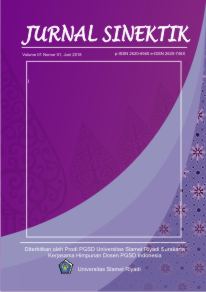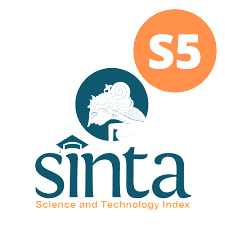PENGARUH MODEL PEMBELAJARAN KOOPERATIF TIPE STAD BERBANTUAN VIDEO PEMBELAJARAN TERHADAP HASIL BELAJAR TEMATIK INTEGRATIF KELAS V
DOI:
https://doi.org/10.33061/js.v5i2.8191Keywords:
learning Model, STAD, learning OutcomesAbstract
The purpose of this study was to determine the effect of the STAD type cooperative learning model assisted by video learning on the thematic learning outcomes of integraphy in fifth grade students of SD Negeri Karangpelem 1 Academic Year 2021/2022. This research is a quantitative research with a pre-experimental method, the research design is one group pretest-posttest design. The population in this study were all fifth grade students of SD Negeri Karangpelem 1, totaling 34 students. The sampling technique used is saturated sampling because all the population is used as a sample. Data collection techniques using tests, observations, and documentation. Test the validity of the data sought by biserial point correlation. The data analysis technique was searched through normality test using the Kolmogorov Smirnov method and hypothesis testing using the Paired Sample T-Test formula. Based on the results of data analysis using paired sample t-test, the results obtained with a value, tcount of 14.707. So it can be concluded that the results of tcount = 14.707 more than ttable at the 5% significance level = 14.707 or tcount > ttable = 14.707 > 2.034 then Ho is rejected and Ha is accepted. Thus the hypothesis which states that: "there is an effect of the STAD type cooperative learning model assisted by video learning on the thematic integrative learning outcomes of fifth grade students of SD Negeri Karangpelem 1 Academic Year 2021/2022" is proven true at a significance level of 5%.
References
Hujair AH Sanaky. (2015). Media Pembelajaran Interaktif-Inovatif. Yogyakarta: Kaubata Dipantara.
Kasmadi dan Nia Siti Sunariah. (2016). Panduan Modern Penelitian Kuantitatif. Bandung: Alfabeta.
Sukmadewi, L.P.M & Suniasih Ni Wayan. (2022). Media Audio Visual Berbasis Kontekstual Pada Muatan IPA Meningkatkan Hasil Belajar. Jurnal Pedagogi dan Pembelajaran Universitas Pendidikan Ganesha. 5(2). 1-11.
Miftahul Huda. (2013). Model-model Pengajaran dan Pembelajaran. Yogyakarta: Pustaka Pelajar.
Ni Kadek Ayu Suryaniti, I Nengah Suadnyana, dan I Ketut Adnyana Putra. (2017). Pengaruh Model Pembelajaran Student Team Achievement Division Berbantuan
Ranty Oktarianda, Mahmud Alpusari, Eddy Novian. (2018). Pengaruh Model Pembelajaran Kooperatif Tipe STAD Berbantuan Media Audio Visual Terhadap Hasil Belajar IPA Siswa Kelas III SD Negeri 42 Pekanbaru. Jurnal Online Mahasiswa. Vol 5, No 1. 1-15. Diakses pada 12 Februari 2022.
Rima Isti Navisha, I Dewa Kade Tastra, I Ketut Dibia (2017). Pengaruh Model STAD Berbantuan Media Video Pembelajaran Terhadap Hasil Belajar IPS Siswa SD Kelas V. Mimbar PGSD Universitas Pendidikan Ganesha. 5(2). 1-11.
Riona Mei Wanita Sari, Nasution, dan Waspodo Tjipto Subroto. (2020). Pengaruh Model Cooperative Learning Tipe STAD Berbantuan Media Video Show Terhadap Ketrampilan Sosial dan Hasil Belajar Siswa Kelas IV Sekolah Dasar. Jurnal Education dan Development. Vol: 8 No: 3. 288-292. Diakses pada 27 Januari 2022.
Rusman, Deni Kurniawan, Cepi Riyana. (2013). Pembelajaran Berbasis Teknologi Informasi dan Komunikasi. Jakarta: Raja Grafindo Persada.
Rusman. (2016). Model-Model Pembelajaran: Mengembangkan Profesionalisme Guru Edisi 2. Jakarta: Rajawali Pers.
Sugiyono. (2017). Metode Penelitian Pendidikan Pendekatan Kuantitatif, Kualitatif, dan R&D. Bandung: Alfabeta.
Wahidmurni. (2017). Metodologi Pembelajaran IPS. Yogyakarta: Ar-Ruzz Media.
Downloads
Published
Issue
Section
License
Copyright (c) 2023 Jurnal Sinektik

This work is licensed under a Creative Commons Attribution-NonCommercial 4.0 International License.
Authors who publish this journal agree to the following terms:
- Authors retain copyright and grant the journal right of first publication with the work simultaneously licensed under a Creative Commons Attribution License that allows others to share the work with an acknowledgement of the work's authorship and initial publication in this journal.
- Authors can separately make additional contractual arrangements for non-exclusive distribution published by the journal (e.g., publish it in a book), with an acknowledgement of its initial publication in this journal.
- Authors are allowed and encouraged to send their work via online (e.g., in the institutional repositories or their website) after published by the journal.















